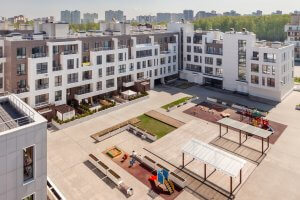- Real estate disputes
- Commercial real estate
- Construction

Longer Reads
The new Electronic Communications Code – round 1 goes to the Operators
Paul Henson comments on the effects of the decision made in Cornerstone Telecommunications Infrastructure Limited v the University of London.
3 minute read
Published 14 November 2018
Key information
- Specialisms
- Real Estate
- Services
- Real estate disputes
- Commercial real estate
- Construction
The decision of the Upper Tribunal in Cornerstone Telecommunications Infrastructure Limited v the University of London (2018) permitted the operator to access, inspect and survey the landowner’s premises as a substantive right under paragraph 3(a) or 3(d) of the Electronic Communications Code (the “Code”). This has thwarted landowners’ tentative attempts to prevent unwanted telecoms apparatus on their properties by allowing them to deny access for initial inspection and survey works.
The facts are straightforward. CTIL wanted access to the University of London’s student accommodation premises known as Lillian Penson Hall which is located opposite Paddington railway station in order to consider whether it was suitable for a new mast. Their previous mast equipment in that area, located on the roof of a local hotel, had to be removed due to impending demolition and CTIL wanted to consider alternative sites. The University of London were not amenable to this approach (no doubt fearing the request for the installation of a mast would follow) and refused CTIL’s requests on the basis that the Code does not expressly refer to operators having a right to survey a site to consider its suitability.
By way of reminder, paragraph 3 of the Code lists 9 rights which the Upper Tribunal (who have jurisdiction to decide telecoms disputes) can grant to operators to assist in the provision of their network services, including:
“(a) To install electronic communications apparatus on, under or over the land; and..
(d)To carry out any works on the land for or in connection with the installation of electronic communications apparatus on, under of over the land or elsewhere”
After a period of unproductive correspondence between agents and solicitors, CTIL served notice on the University Of London requiring an “interim right” pursuant to paragraph 26 of the Code which would allow it to survey the rooftop for a period of 28 days and on payment of £50. Code rights may be imposed by the Upper Tribunal on an interim basis for a specified period or until the occurrence of a specified event. It is worth noting in this a case that CTIL were not suggesting that they were going to follow any such survey with a request under paragraph 20 of the Code (which allows operators to force a Code agreement on a landowner) and they were merely seeking access to undertake non-intrusive survey works as a standalone requirement.
When considering an application for interim rights under paragraph 26 the Upper Tribunal is required to consider the tests that operators must satisfy to obtain a paragraph 20 ‘forced’ agreement. However, operators requesting an interim right need only demonstrate they have a “good arguable case” that:
- The landowner can be compensated adequately in money for the prejudice it suffers; and
- The public benefit in making the order outweighs the prejudice to the landowner.
From a procedural point of view the Upper Tribunal confirmed that interim rights applications would normally be dealt with as a “paper” exercise in order to be dealt with quickly (and certainly in less than 6 months). There will be no oral evidence and limited disclosure and so the operator, who has the burden of proving it has a good arguable case on the requirements set out above, must ensure it has adequate evidence at an early stage.
The Upper Tribunal decided that the operator’s Code rights “to install” at paragraph 3(a) and 3(d) should be construed in broad terms. By implication, these Code rights must also attract ancillary rights to access a landowner’s site to consider its viability in order to be effective. No doubt the Upper Tribunal were keen to avoid endorsing the position where a landowner could effectively “ransom” an operator for access to their site and which would defeat the overall purpose of the Code which is to facilitate the rolling out of improved telecommunications apparatus. The Upper Tribunal were also persuaded that it is not a requirement for seeking an interim right under paragraph 26 for an operator to demonstrate that a permanent agreement will follow.
Operators, therefore, have a powerful weapon in their armoury to obtain access to a landowners’ property in order to consider its potential. To prevent a successful interim right application a landowner will have to show that; either the prejudice it suffers cannot be compensated in money; or that they will suffer more than the potential benefit to the public at large. On the back of this decision we expect operators to use the threat of interim rights applications to access many more sites and will offer standard (and not overly financially generous) agreements to landowners in order to do so.
Decisions under the new Code are now starting to flow from the Upper Tribunal and it appears that things are moving in the operator’s direction. This is perhaps unsurprising given their lobbying for enhanced rights to be able to increase their network coverage in light of the impending roll-out of their 5G networks in the next few years. Landowners with properties in strategic locations who receive requests from operators to survey their site are therefore well advised to commence negotiations with operators in order to keep a measure of control and certainty in such matters. This will also avoid unwanted proceedings in the Upper Tribunal which will incur the unwanted cost and disruption that, no doubt, befell the University of London in this case.
Cornerstone Telecommunications Infrastructure Limited v the University of London (2018) UKUT 0356
Related content
Longer Reads
The new Electronic Communications Code – round 1 goes to the Operators
Paul Henson comments on the effects of the decision made in Cornerstone Telecommunications Infrastructure Limited v the University of London.
Published 14 November 2018
Associated sectors / services
The decision of the Upper Tribunal in Cornerstone Telecommunications Infrastructure Limited v the University of London (2018) permitted the operator to access, inspect and survey the landowner’s premises as a substantive right under paragraph 3(a) or 3(d) of the Electronic Communications Code (the “Code”). This has thwarted landowners’ tentative attempts to prevent unwanted telecoms apparatus on their properties by allowing them to deny access for initial inspection and survey works.
The facts are straightforward. CTIL wanted access to the University of London’s student accommodation premises known as Lillian Penson Hall which is located opposite Paddington railway station in order to consider whether it was suitable for a new mast. Their previous mast equipment in that area, located on the roof of a local hotel, had to be removed due to impending demolition and CTIL wanted to consider alternative sites. The University of London were not amenable to this approach (no doubt fearing the request for the installation of a mast would follow) and refused CTIL’s requests on the basis that the Code does not expressly refer to operators having a right to survey a site to consider its suitability.
By way of reminder, paragraph 3 of the Code lists 9 rights which the Upper Tribunal (who have jurisdiction to decide telecoms disputes) can grant to operators to assist in the provision of their network services, including:
“(a) To install electronic communications apparatus on, under or over the land; and..
(d)To carry out any works on the land for or in connection with the installation of electronic communications apparatus on, under of over the land or elsewhere”
After a period of unproductive correspondence between agents and solicitors, CTIL served notice on the University Of London requiring an “interim right” pursuant to paragraph 26 of the Code which would allow it to survey the rooftop for a period of 28 days and on payment of £50. Code rights may be imposed by the Upper Tribunal on an interim basis for a specified period or until the occurrence of a specified event. It is worth noting in this a case that CTIL were not suggesting that they were going to follow any such survey with a request under paragraph 20 of the Code (which allows operators to force a Code agreement on a landowner) and they were merely seeking access to undertake non-intrusive survey works as a standalone requirement.
When considering an application for interim rights under paragraph 26 the Upper Tribunal is required to consider the tests that operators must satisfy to obtain a paragraph 20 ‘forced’ agreement. However, operators requesting an interim right need only demonstrate they have a “good arguable case” that:
- The landowner can be compensated adequately in money for the prejudice it suffers; and
- The public benefit in making the order outweighs the prejudice to the landowner.
From a procedural point of view the Upper Tribunal confirmed that interim rights applications would normally be dealt with as a “paper” exercise in order to be dealt with quickly (and certainly in less than 6 months). There will be no oral evidence and limited disclosure and so the operator, who has the burden of proving it has a good arguable case on the requirements set out above, must ensure it has adequate evidence at an early stage.
The Upper Tribunal decided that the operator’s Code rights “to install” at paragraph 3(a) and 3(d) should be construed in broad terms. By implication, these Code rights must also attract ancillary rights to access a landowner’s site to consider its viability in order to be effective. No doubt the Upper Tribunal were keen to avoid endorsing the position where a landowner could effectively “ransom” an operator for access to their site and which would defeat the overall purpose of the Code which is to facilitate the rolling out of improved telecommunications apparatus. The Upper Tribunal were also persuaded that it is not a requirement for seeking an interim right under paragraph 26 for an operator to demonstrate that a permanent agreement will follow.
Operators, therefore, have a powerful weapon in their armoury to obtain access to a landowners’ property in order to consider its potential. To prevent a successful interim right application a landowner will have to show that; either the prejudice it suffers cannot be compensated in money; or that they will suffer more than the potential benefit to the public at large. On the back of this decision we expect operators to use the threat of interim rights applications to access many more sites and will offer standard (and not overly financially generous) agreements to landowners in order to do so.
Decisions under the new Code are now starting to flow from the Upper Tribunal and it appears that things are moving in the operator’s direction. This is perhaps unsurprising given their lobbying for enhanced rights to be able to increase their network coverage in light of the impending roll-out of their 5G networks in the next few years. Landowners with properties in strategic locations who receive requests from operators to survey their site are therefore well advised to commence negotiations with operators in order to keep a measure of control and certainty in such matters. This will also avoid unwanted proceedings in the Upper Tribunal which will incur the unwanted cost and disruption that, no doubt, befell the University of London in this case.
Cornerstone Telecommunications Infrastructure Limited v the University of London (2018) UKUT 0356
Associated sectors / services
- Real estate disputes
- Commercial real estate
- Construction
Need some more information? Make an enquiry below.
Enjoy reading our articles? why not subscribe to notifications so you’ll never miss one?
Subscribe to our articlesMessage us on WhatsApp (calling not available)
Please note that Collyer Bristow provides this service during office hours for general information and enquiries only and that no legal or other professional advice will be provided over the WhatsApp platform. Please also note that if you choose to use this platform your personal data is likely to be processed outside the UK and EEA, including in the US. Appropriate legal or other professional opinion should be taken before taking or omitting to take any action in respect of any specific problem. Collyer Bristow LLP accepts no liability for any loss or damage which may arise from reliance on information provided. All information will be deleted immediately upon completion of a conversation.
Close





















































